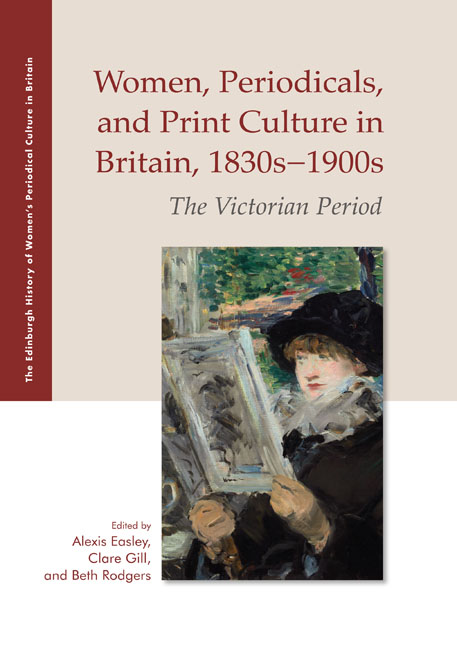Book contents
- Frontmatter
- Contents
- List of Illustrations
- Acknowledgments
- Introduction: Women, Periodicals, and Print Culture in the Victorian Period
- Part I (Re)Imagining Domestic Life
- Part II Constructing Modern Girls and Young Women
- Constructing Modern Girls and Young Women: Introduction
- 7 Promoting a Do-It-Yourself Spirit: Samuel Beeton's Young Englishwoman
- 8 Claiming Medicine as a Profession for Women: The English Woman's Journal's Campaign for Female Doctors
- 9 Encouraging Charitable Work and Membership in the Girls’ Friendly Society through British Girls’ Periodicals
- 10 ‘Welcome and Appeal for the “Maid of Dundee”’: Constructing the Female Working-Class Bard in Ellen Johnston's Correspondence Poetry, 1862–1867
- 11 The Editor of the Period: Alice Corkran, the Girl's Realm, and the Woman Editor
- 12 The ‘Most-Talked-Of Creature in the World’: The ‘American Girl’ in Victorian Print Culture
- Part III Women and Visual Culture
- Part IV Making Space for Women
- Part V Constructing Women Readers and Writers
- Part VI Intervening in Political Debates
- Notes on Contributors
- Index
- Plate section
Constructing Modern Girls and Young Women: Introduction
from Part II - Constructing Modern Girls and Young Women
Published online by Cambridge University Press: 25 October 2019
- Frontmatter
- Contents
- List of Illustrations
- Acknowledgments
- Introduction: Women, Periodicals, and Print Culture in the Victorian Period
- Part I (Re)Imagining Domestic Life
- Part II Constructing Modern Girls and Young Women
- Constructing Modern Girls and Young Women: Introduction
- 7 Promoting a Do-It-Yourself Spirit: Samuel Beeton's Young Englishwoman
- 8 Claiming Medicine as a Profession for Women: The English Woman's Journal's Campaign for Female Doctors
- 9 Encouraging Charitable Work and Membership in the Girls’ Friendly Society through British Girls’ Periodicals
- 10 ‘Welcome and Appeal for the “Maid of Dundee”’: Constructing the Female Working-Class Bard in Ellen Johnston's Correspondence Poetry, 1862–1867
- 11 The Editor of the Period: Alice Corkran, the Girl's Realm, and the Woman Editor
- 12 The ‘Most-Talked-Of Creature in the World’: The ‘American Girl’ in Victorian Print Culture
- Part III Women and Visual Culture
- Part IV Making Space for Women
- Part V Constructing Women Readers and Writers
- Part VI Intervening in Political Debates
- Notes on Contributors
- Index
- Plate section
Summary
IN A CONTROVERSIAL ARTICLE first published in the Saturday Review in 1868, Eliza Lynn Linton (1822–98) describes, in inflammatory terms, the ostensible moral degeneration of the character of the ‘Girl of the Period.’ Linton draws a sharp distinction between the ‘simple and genuine girl of the past, with her tender little ways and pretty bashful modesties’ and the new form of modern girl, ‘this loud and rampant modernization, with her false red hair and painted skin, talking slang as glibly as a man, and by preference leading the conversations to doubtful subjects’ (p. 340). The modern girl's participation in the vulgar spectacle of cosmetics and dress was, for Linton, bound up with broader anxieties about the sexualisation of young women, not least because of their aesthetic proximity to the visual codes associated with the prostitute.
It is no coincidence that four of the essays in this section make reference to Linton's article and the anxieties about girlhood it expresses. While the essays here demonstrate that concerns about the regulation of girls’ behaviour both preceded and succeeded the mid-Victorian moment within which Linton was writing, it nevertheless becomes clear that her views endured as a popular yardstick by which to measure the progress or decline of girls in culture and society until the end of the century. This was particularly the case in the periodicals aimed at girls and young women that flourished at this time, where the caustic commentary put forward in ‘The Girl of the Period’ frequently functioned as a cultural formation to be either upheld or resisted. What emerges clearly from the essays that follow is a sense of ‘the girl’ as being, contra to Linton's binary formulation, an ever-shifting and contested category and of girls’ periodical culture as being both reflective of and responsive to a plurality of lived and imagined girlhoods.
This sense of the complexity and heterogeneity of Victorian girlhood(s) has emerged clearly from the scholarship that has flourished in recent years. Sally Mitchell's groundbreaking study The New Girl: Girls’ Culture in England, 1880–1915 influentially speaks of the ‘provisional free space’ of girlhood, which is defined not only as a transitional state anchored ambiguously between childhood and adulthood but also as a period set apart from the poles that buttress it by a distinctive constellation of characteristics, experiences, and expectations (1995: 3).
- Type
- Chapter
- Information
- Women, Periodicals and Print Culture in Britain, 1830s–1900sThe Victorian Period, pp. 99 - 102Publisher: Edinburgh University PressPrint publication year: 2019

